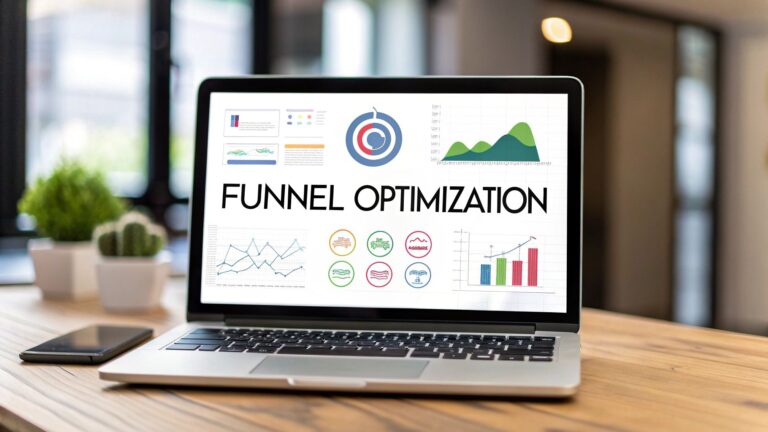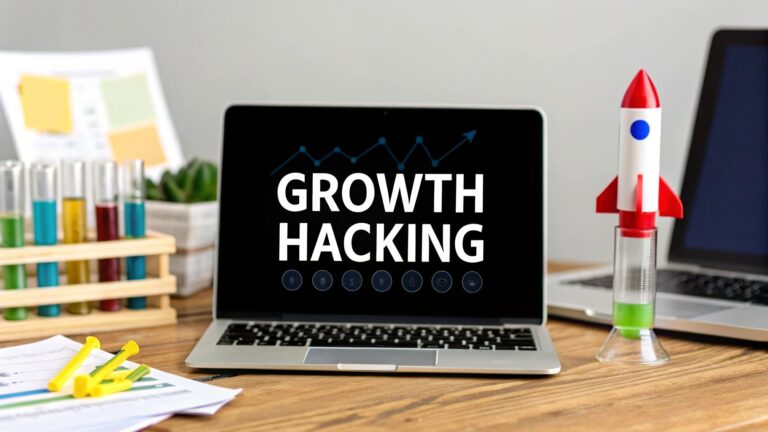What is Intelligent Automation? Transform Your Business Now
Let's get straight to the point. Intelligent automation (IA) is what happens when you combine the muscle of Robotic Process Automation (RPA) with the brain of artificial intelligence (AI).
Imagine a standard factory robot that welds the same car door over and over. That's traditional automation. Now, give that robot the ability to see a dent, decide it needs a different approach, and adapt its technique on the fly. That's intelligent automation.
Understanding Intelligent Automation

At its heart, intelligent automation is all about graduating from simple, rigid tasks. Your average automation tool is stuck on a script: if this happens, then do that. IA breaks free from that script by adding cognitive skills, which allows it to handle the messy, unpredictable nature of real business.
Instead of just copying human clicks and keystrokes, IA systems can actually understand what they're looking at. They can read unstructured data, figure out the context, and get smarter over time. This leap from just "doing" to "thinking and doing" is what truly sets IA apart.
Moving Beyond Basic Rules
The real magic of IA is how it deals with variation. A basic bot will grind to a halt if a button on a website moves or an invoice arrives in a new format. An intelligent system, on the other hand, can understand the goal—like finding the total amount on an invoice—and hunt for that information no matter how the document is laid out.
This is a game-changer for processes that require a bit of judgment, such as:
- Reading customer emails and understanding the sentiment and intent behind the words.
- Pulling specific data points from a jumble of different document types, from contracts to purchase orders.
- Making informed decisions by spotting patterns in historical data.
This is already happening in specialized fields. For instance, forward-thinking legal teams are using sophisticated legal document automation strategies to analyze and pull key information from thousands of contracts at once—a task that would take a human team weeks.
To give you a clearer picture, here’s a quick breakdown of how IA's different parts work together to deliver real business results.
Intelligent Automation at a Glance
| Component | Function | Business Outcome |
|---|---|---|
| Robotic Process Automation (RPA) | Acts as the "hands," executing structured, repetitive tasks. | Increased speed and efficiency for rule-based work. |
| Artificial Intelligence (AI) | Provides the "brain," enabling decision-making and analysis. | Smarter, data-driven judgments and handling of exceptions. |
| Machine Learning (ML) | Allows the system to learn from data and improve over time. | Continuous process improvement and better accuracy. |
| Natural Language Processing (NLP) | Understands and interprets human language (text and speech). | Automation of communication and unstructured data extraction. |
| Process Mining | Discovers and analyzes how processes actually run. | Identifies bottlenecks and opportunities for automation. |
This table shows how IA isn't a single technology but a powerful toolkit. By combining these components, you can build systems that tackle complex, end-to-end workflows.
A Growing Market and a Clear Advantage
The business world is catching on fast. The global intelligent automation market was valued at USD 9.1 billion in 2024 and is expected to explode to USD 84.2 billion by 2037. This isn’t just hype; it's a fundamental shift in how modern businesses operate.
By blending AI’s decision-making with RPA’s reliable execution, businesses can finally automate entire workflows that were once considered too dynamic or complex for a machine. This isn’t just about working faster—it's about working smarter.
With this foundation, we can now dig deeper into the specific components and benefits that make intelligent automation such a powerful force for any organization.
A Look Under the Hood: The Core Components of IA
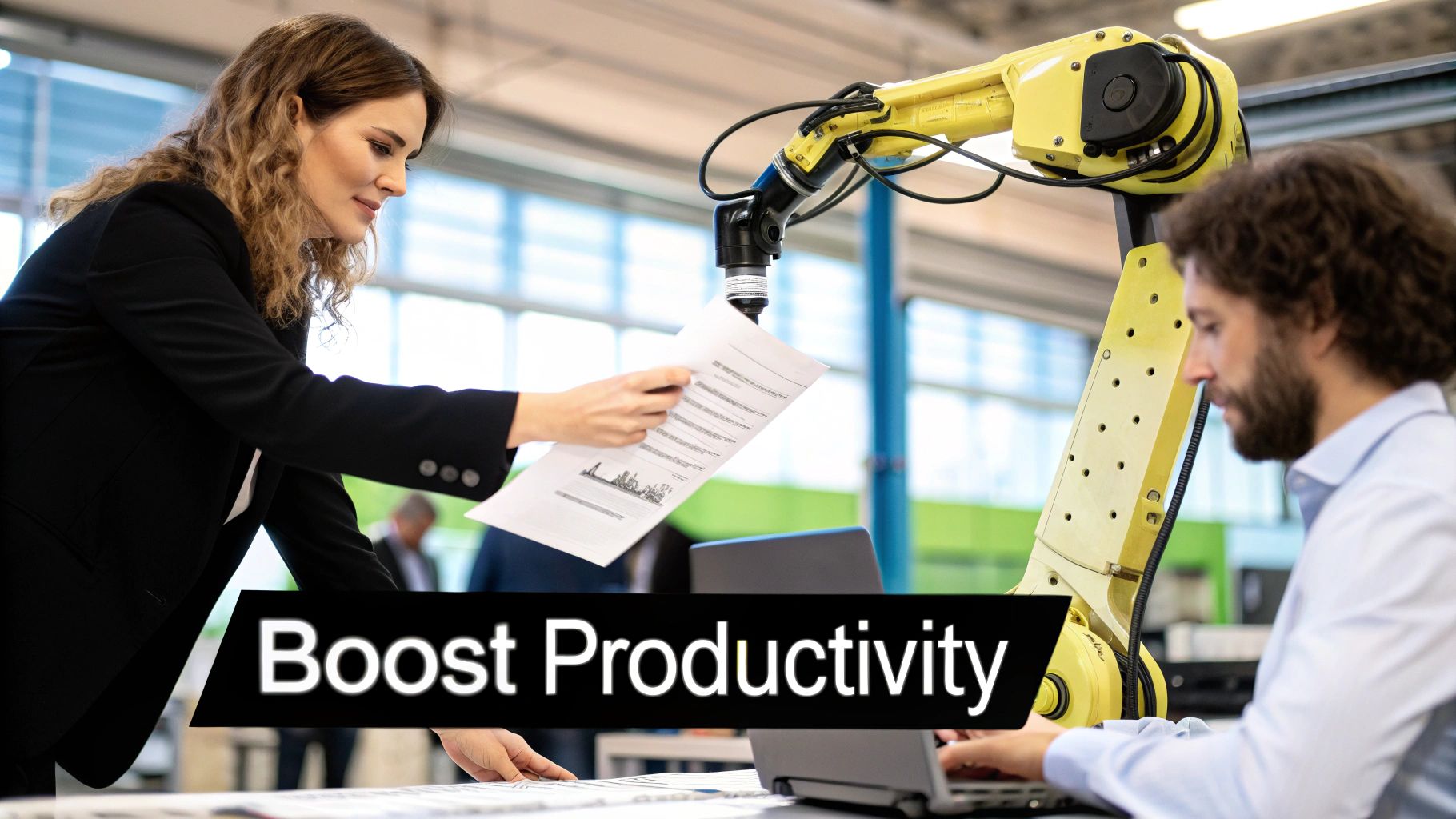
Intelligent automation isn't just one piece of software; it's more like a high-tech assembly line where different specialized technologies work together. To really get a handle on IA, you have to understand the key players on the team.
Think of it this way: you're building a crew for a complex mission. Each member has a unique skill, but their true power comes from how they collaborate. Let's meet the team.
Robotic Process Automation: The Digital Hands
First up is Robotic Process Automation (RPA). This is the workhorse, the digital "hands" of the operation. RPA is built to execute structured, repetitive tasks with incredible speed and perfect accuracy.
Ever seen someone spend their afternoon copying data from a spreadsheet and pasting it into a CRM? That's a classic job for RPA. A bot can mimic those exact clicks and keystrokes to get the work done flawlessly, 24/7, without ever needing a coffee break.
RPA is a genius at handling predictable, rule-based workflows. The catch? It gets stuck when things change. If a website's layout is updated or an invoice shows up in a new format, a basic RPA bot is out of its depth. That’s where the other members of the crew step in.
Artificial Intelligence: The Cognitive Engine
If RPA provides the hands, Artificial Intelligence (AI) brings the brain. AI is the cognitive engine that gives the whole system its "intelligence," allowing it to make decisions, spot patterns, and deal with unexpected issues.
AI goes far beyond simple "if this, then that" rules. It sifts through massive amounts of data to make predictions and judgments. This lets the automation tackle tasks that used to be strictly for humans, like figuring out which customer support tickets are the most urgent based on the tone of the message.
AI is what allows automation to graduate from just following instructions to actively solving problems. It's the difference between a simple calculator and a data scientist.
This ability is a huge reason why the intelligent automation market is expected to hit USD 115.17 billion by 2034, as detailed in the full market report. And a key part of that AI engine is its ability to learn.
Machine Learning: The Ability to Learn on the Job
Machine Learning (ML) is a specialized field of AI that gives the system the power to learn from experience without needing to be reprogrammed. It’s what makes intelligent automation so adaptive.
For instance, you can train an ML model on thousands of past invoices. Over time, it learns to pinpoint key details like vendor names, due dates, and totals, no matter how the document is laid out. The more invoices it sees, the smarter and more accurate it gets.
This self-improvement cycle means your automation doesn't become obsolete. It actually evolves right alongside your business, constantly getting better at its job.
Natural Language Processing: The Universal Translator
So much of a company's critical data is locked away in plain human language—emails, support chats, customer reviews, and legal contracts. Natural Language Processing (NLP) is the component that acts as a universal translator, enabling the system to understand, interpret, and even generate human language.
With NLP, your automation can:
- Read an email to understand a customer's request and route it to the right person.
- Analyze thousands of survey responses to pull out common themes and gauge customer sentiment.
- Power a chatbot that can hold a genuinely helpful conversation with a user.
A powerful, real-world application of this is Intelligent Document Processing (IDP), which uses NLP to pull structured data out of unstructured documents like PDFs and scans. You can dive deeper into this in our guide on what is intelligent document processing.
When you bring all these components together, you get a system that can manage complex, end-to-end processes that were once strictly human territory. It can read an email, extract the necessary data, plug it into the right systems, make a judgment call based on that information, and even communicate the result—all without a person lifting a finger.
IA vs RPA vs Hyperautomation
It's easy to get lost in the jargon of automation. You'll hear terms like Robotic Process Automation (RPA), Intelligent Automation (IA), and Hyperautomation thrown around, sometimes interchangeably. But they're not the same thing. Think of them as different points on an evolutionary scale, each building on the last.
Understanding where they differ is crucial because picking the right approach can make or break your automation strategy. It’s like having a toolbox—you need to know whether the job calls for a simple wrench, a power drill, or a full-on workshop.
Starting with Robotic Process Automation
Let's start with the basics. Robotic Process Automation (RPA) is the workhorse of the automation world. It’s a technology built to handle simple, repetitive, rule-based tasks—the kind of digital grunt work that bogs down your team.
RPA bots are essentially digital employees that follow a very strict script. They mimic human actions like clicking, typing, and moving files between applications. Give an RPA bot a stack of 1,000 perfectly formatted invoices, and it will process them flawlessly. But throw it one with a slightly different layout, and it will stumble. It can only do what it's told; it can't think.
If this is a new concept for you, our guide on what is Robotic Process Automation is a great place to get up to speed.
Evolving with Intelligent Automation
This is where Intelligent Automation (IA) comes in. IA takes the "doing" of RPA and adds a layer of "thinking" by incorporating technologies like artificial intelligence (AI), machine learning (ML), and natural language processing (NLP).
This cognitive ability is a game-changer. An IA system can handle unstructured data, manage exceptions, and even make judgments based on what it has learned. Back to our invoice example: an IA system doesn’t need a perfect template. Its AI can read and understand invoices in various formats because it's been trained to identify key data points like dates, amounts, and vendor names, no matter where they are on the page. It understands context, not just rules.
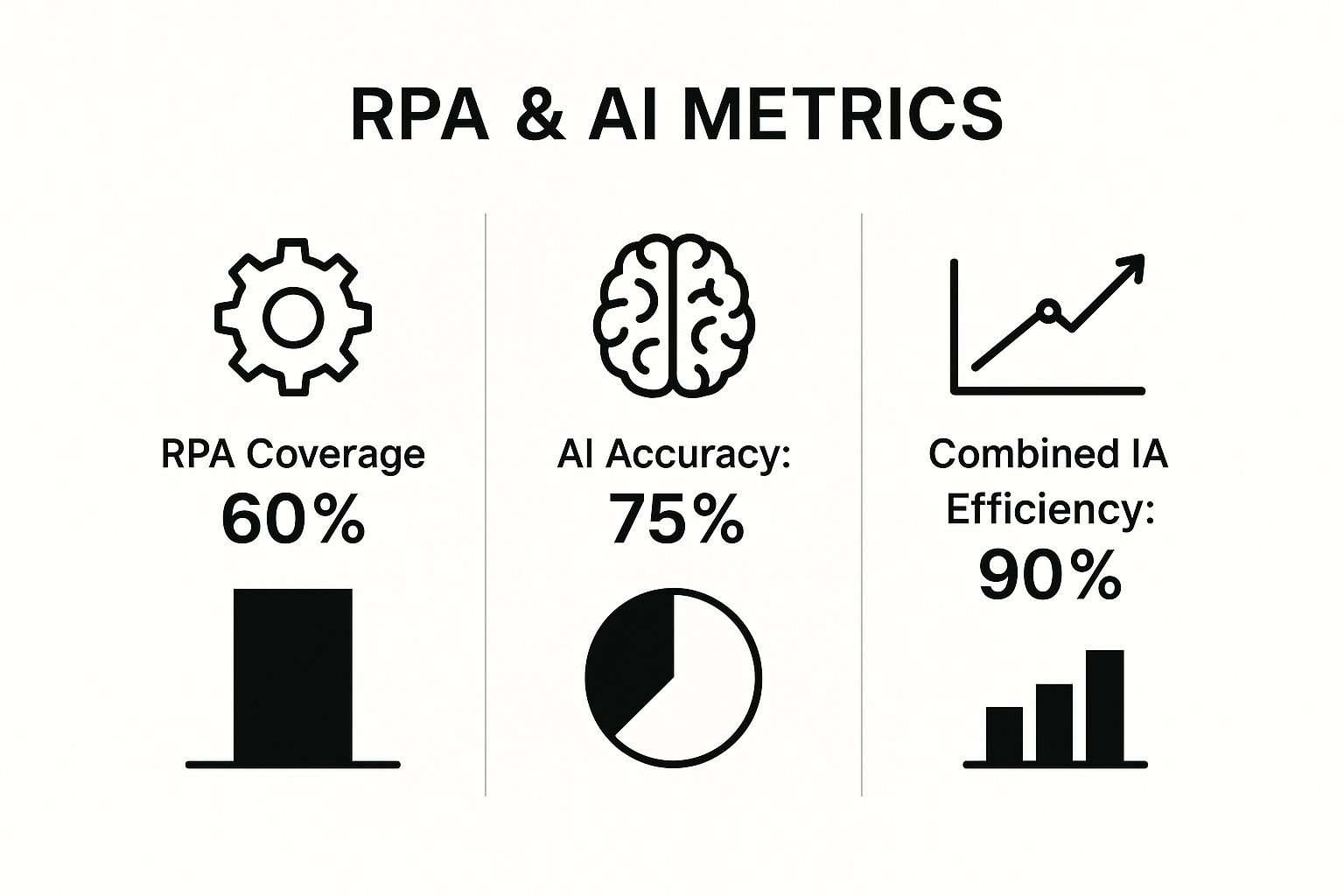
As you can see, combining RPA's raw execution power with AI's intelligence creates something far more capable than either technology on its own.
Reaching for Hyperautomation
Finally, we arrive at Hyperautomation. This isn't just another technology; it's a philosophy. It’s a business-wide strategy that aims to identify, vet, and automate as many processes as possible across the entire organization.
Hyperautomation orchestrates a whole suite of tools. It uses RPA and IA as its foundation but adds process mining, advanced analytics, and other technologies to create a holistic system. The goal is to build an end-to-end, self-improving automation ecosystem.
Hyperautomation isn't just about deploying bots. It's about creating a culture where technology and people work together to continuously find and optimize every possible workflow.
This creates a powerful feedback loop where the system is always discovering new opportunities to get smarter and more efficient. It’s the blueprint for building a truly automated enterprise.
Comparing Automation Technologies
To really nail down the differences, a side-by-side comparison is helpful. The table below breaks down the key distinctions in a straightforward way.
| Feature | Robotic Process Automation (RPA) | Intelligent Automation (IA) | Hyperautomation |
|---|---|---|---|
| Primary Goal | Automate specific, repetitive tasks. | Automate complex, end-to-end processes. | Automate everything possible across the business. |
| Data Handling | Works with structured data only. | Handles both structured and unstructured data. | Manages all data types across multiple systems. |
| Core Technology | Rule-based software bots. | RPA combined with AI, ML, and NLP. | A suite of tools including IA, process mining, and analytics. |
| Decision Making | Follows predefined "if-then" rules. | Makes data-driven decisions and judgments. | Enables strategic, organization-wide decision-making. |
| Example Use Case | Copying data from a spreadsheet to a CRM. | Processing and approving loan applications. | Optimizing the entire supply chain from order to delivery. |
At the end of the day, RPA is your go-to for tactical task automation. IA is a more sophisticated solution for automating entire processes. And Hyperautomation is the strategic framework for weaving automation into the very fabric of your business. Each one builds on the last, offering a greater potential impact.
The Real Business Benefits of IA
Knowing what intelligent automation is made of is one thing, but seeing what it can do for your bottom line is another story entirely. Let’s move past the technical jargon. The real value of IA is in the tangible, everyday problems it solves—the ones that drain your resources, slow you down, and frustrate both your customers and your team.
The conversation needs to shift from what the technology is to what it does. For instance, don't just think about automating a single data entry task. Think bigger. IA can orchestrate an entire accounts payable workflow—receiving invoices in any format, pulling the right data, checking it against purchase orders, and routing it for approval—all without a single human click. This is where theory gets real, fast.
Driving Radical Efficiency
The first thing you'll notice is a massive leap in operational efficiency. IA systems work 24/7 without needing a coffee break, crunching through high-volume tasks at a speed that humans just can't match. This isn’t just about doing old tasks faster; it’s about fundamentally rethinking how much your business can actually accomplish.
By automating processes from start to finish, you can slash cycle times. Take customer onboarding. A process that once took days of shuffling paperwork and verifying data can now happen in minutes. IA can read applications, validate information against different sources, and kick off the next step automatically. That kind of speed isn't just a convenience; it's a serious competitive edge.
Enhancing Accuracy and Compliance
Let’s be honest, people make mistakes. It’s unavoidable in manual, detail-oriented work. A misplaced decimal or a typo can snowball into costly invoicing errors or, even worse, serious compliance breaches. Intelligent automation all but wipes out that risk, executing tasks with near-perfect accuracy, every single time.
Intelligent Automation doesn't just reduce the chance of errors; it systematically removes the opportunity for them to occur. This creates a more reliable and predictable operational foundation.
In heavily regulated fields like finance or healthcare, this isn't a "nice-to-have"—it's essential. IA can enforce your business rules without exception, create a detailed audit trail for every action, and guarantee that critical compliance checks are never overlooked. That doesn't just cut down on risk; it makes audits and reporting infinitely less painful.
Delivering Smarter Decision-Making
Because intelligent automation is built on AI and machine learning, it gets smarter over time. It learns from the data it processes, turning your day-to-day operations into a goldmine of strategic insights. The system can start to spot trends, flag potential issues, and even make predictions about what's coming next.
Imagine an IA system managing your supply chain. It could:
- Analyze past sales data to forecast demand with greater accuracy.
- Monitor shipping routes in real-time to predict delays before they happen.
- Suggest inventory adjustments to prevent stockouts or costly overstock.
Suddenly, automation isn't just about execution; it's a strategic partner helping you make proactive, data-driven decisions. This is a huge reason for its rapid growth. Right now, North America holds a 39.6% market share in the IA space, largely because industries are using it to sharpen their decision-making. You can explore more market trends and findings to get a better sense of this global shift.
Elevating Employee and Customer Experiences
Perhaps the most overlooked benefit of IA is its impact on people. When you hand over the tedious, mind-numbing tasks to automation, you free up your team to focus on what humans do best: solving complex problems, thinking strategically, and building real relationships with customers.
This creates a powerful ripple effect. First, employee morale gets a huge boost. People are more engaged when they're working on meaningful projects instead of copy-pasting data all day. Second, that engagement translates directly into a better customer experience. When your team has more time and energy for customers, they can provide the kind of personalized, thoughtful support that builds loyalty and keeps people coming back.
Intelligent Automation in Action
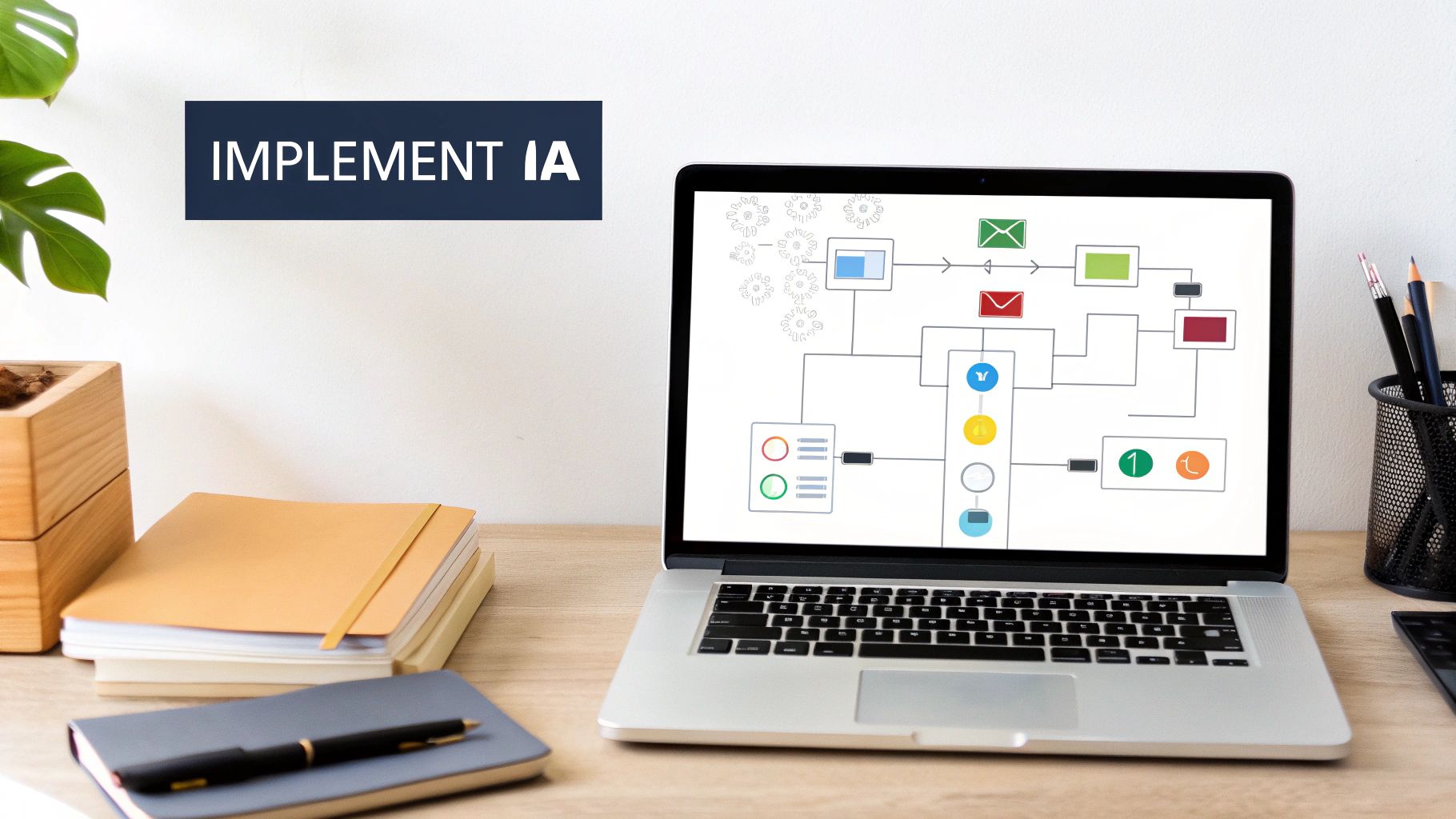
The theory is great, but where the rubber really meets the road is in the real world. This is where intelligent automation stops being a buzzword and starts solving expensive, frustrating business problems and unlocking new ways to grow.
Looking at how B2B and SaaS companies are actually using IA shows just how practical it is. It's not some far-off, futuristic concept; it's already overhauling core operations in finance, logistics, HR, and customer support. Let's dig into a few examples that really bring this to life.
Transforming Finance with Smarter Onboarding
For any financial firm, customer onboarding has always been a major headache. It’s slow, buried in paperwork, and riddled with manual verification checks—a perfect recipe for errors and a terrible first impression for new clients.
-
Problem: A wealth management firm was stuck with an onboarding process that took days. Analysts had to manually sift through ID documents, utility bills, and financial statements, causing delays and friction right from the start.
-
Solution: The firm brought in an intelligent automation system. The new workflow uses Computer Vision to instantly scan and pull data from client IDs and NLP to make sense of unstructured bank statements. The system then automatically checks this information against external databases to verify identities and run initial risk checks.
-
Outcome: The impact was immediate. The firm saw a stunning 90% reduction in document processing time, slashing the average onboarding from three days to less than an hour. This wasn't just an efficiency win; it fundamentally improved the client experience from day one.
Optimizing Logistics with Real-Time Supply Chains
The logistics industry runs on incredibly tight margins, where every minute and decision has a direct impact on the bottom line. A supply chain is a massive juggling act of shipping schedules, fluctuating inventory, and a thousand other variables.
Intelligent automation gives logistics companies the ability to not just react to disruptions, but to anticipate and prevent them. It turns the supply chain from a rigid sequence of steps into a dynamic, self-optimizing system.
Think about a large distribution company constantly wrestling with delivery schedules and stock levels. An IA platform can pull in data from weather forecasts, live traffic reports, and vehicle sensors to dynamically reroute trucks and sidestep delays. At the same time, it can analyze sales patterns to predict a sudden demand for a product, automatically adjusting inventory at different warehouses to make sure nothing goes out of stock.
Redefining SaaS Customer Support
In the SaaS world, customer support isn't just a cost center—it's a critical part of the product. But as a company’s user base explodes, support teams get buried under a mountain of tickets, most of which are repetitive and time-consuming.
-
Problem: A fast-growing SaaS provider watched its support team spend all day just categorizing tickets and answering the same basic questions over and over. This meant high-priority, complex issues were left waiting, leading to slow response times and unhappy customers.
-
Solution: The company rolled out an IA-powered ticketing system. Using NLP, the system now reads and understands every incoming support request. It automatically figures out the category, gauges urgency through sentiment analysis, and sends the ticket to the right specialist. For common questions, it can even fire back an instant, accurate answer from the knowledge base.
-
Outcome: The support team was finally free to focus on solving the tough problems. The company achieved a 40% increase in customer satisfaction scores and cut the average ticket resolution time by 60%, all while managing even more requests.
And these aren't the only areas. Intelligent automation is making a huge difference in other functions, too. In human resources, for example, tasks are streamlined with automated candidate screening with AI tools, helping teams find the best talent much faster. Ultimately, these examples prove that IA isn't about replacing people. It's about empowering them to do their best work by taking the tedious, data-heavy tasks off their plates.
Your Roadmap to Implementing Intelligent Automation
Jumping into intelligent automation isn’t about buying fancy new software; it's about adopting a strategic mindset. A successful IA journey always begins with a clear plan, one that’s laser-focused on business outcomes, not just the technology itself. This roadmap is your key to ensuring your efforts pay off with a powerful and sustainable return from day one.
The first move is to look inward and pinpoint the right processes to start with. It’s tempting to tackle the biggest, most complex problem, but that's a common mistake. Instead, hunt for the tasks that are high-volume, repetitive, rule-based, and notorious for human error. These are your quick wins.
Think about things like processing invoices, endless data entry, or validating customer information.
Find and Prioritize Your Processes
To find the best candidates for automation, you have to get a real, unfiltered look at how work actually gets done in your organization. This is where specific tools and techniques come into play. A fantastic starting point is learning about what is process mining—it helps you uncover the hidden inefficiencies and bottlenecks you didn't even know you had.
Once you have a list of potential processes, you can prioritize them using two simple filters:
- Impact: How much value will automating this actually create? Think in terms of hard cost savings, hours given back to your team, and a drop in error rates.
- Feasibility: How difficult will this be to automate? You want to start with simpler processes to build momentum and prove the value of IA quickly.
This approach lets you grab the "low-hanging fruit" first, creating immediate wins that get everyone on board for bigger, more ambitious projects down the line.
Assemble Your Team and Tools
Intelligent automation is absolutely a team sport. You'll need a cross-functional group with a mix of skills: business analysts who know the processes inside and out, IT specialists to handle the infrastructure, and a project manager to keep everything on track. This kind of collaboration is what ensures the final solution solves a real business problem.
Choosing the right tools is just as critical. The technology has to match the complexity of the job. For instance, recent advancements like the next-generation Optical Character Recognition (OCR) API launched by ABBYY in April 2025 have massively improved the accuracy of pulling data from documents, making automation more reliable than ever. You can learn more about the intelligent automation market and its key technologies to see what's out there.
Launch a Pilot Project
Whatever you do, don't attempt a massive, big-bang rollout from the get-go. The smartest path forward is to launch a pilot project, focusing on one of those high-impact, low-complexity processes you already identified.
A pilot project is your proof of concept. Its job is to show tangible value fast, test your assumptions in a low-risk setting, and get key stakeholders excited and bought into the vision.
A successful pilot gives you the hard data and the compelling success story you need to justify more investment. It also helps you iron out any wrinkles in your implementation process, building a solid foundation for what comes next.
Establish Governance to Scale
Once your pilot is a proven success, the final piece of the puzzle is to think about scale. This means establishing clear governance and a Center of Excellence (CoE). Your CoE acts as the central hub for every automation initiative—it sets the best practices, manages the technology stack, and makes sure every new project aligns with your big-picture business goals.
Following this structured path turns intelligent automation from a one-off project into a continuous improvement engine that drives efficiency and innovation across your entire company.
Frequently Asked Questions
As you start exploring what intelligent automation can do, some common questions naturally come up. We've gathered the ones we hear most often to give you clear, straightforward answers.
How Is Intelligent Automation Different From AI?
It helps to think of Artificial Intelligence (AI) as a brilliant, powerful engine. On its own, it has massive potential. Intelligent Automation (IA) is the finely tuned, high-performance vehicle built around that engine, designed to get you from point A to point B.
AI is the broader science of making machines smart. IA, on the other hand, is the practical application of that intelligence. It combines AI with other tools like RPA to automate complex, end-to-end business processes. Essentially, IA is about putting AI to work in a structured, purposeful way.
What Skills Are Needed for an IA Team?
Building a solid IA team is about bringing together a mix of talents. You'll want business analysts who truly understand your company's workflows and can spot automation opportunities. Then you have automation developers who actually build the solutions, and data scientists who fine-tune the AI models.
Beyond that, you need IT specialists to keep the underlying infrastructure running smoothly and, of course, a good project manager to orchestrate everything. But perhaps most importantly, you need people with strong change management skills to help everyone in the organization embrace the new way of working.
The real point of intelligent automation isn't to replace people—it's to supercharge them. It takes over the tedious, data-intensive work, which frees up your team to focus on the things humans are best at: creative problem-solving, strategic thinking, and building strong customer relationships.
Will Intelligent Automation Replace Jobs?
This is a big concern for many, but the reality is more about evolution than elimination. IA shifts the focus of human work away from monotonous tasks and toward more valuable, strategic activities.
Instead of cutting jobs, it creates new roles centered on automation strategy, process design, and data interpretation. It gives your team their time back, allowing them to make a bigger impact. The goal is to elevate what your people can do, not make them obsolete.
Ready to stop wasting time on manual tasks and start scaling your business? MakeAutomation provides the expert frameworks and hands-on support to implement powerful automation solutions that deliver real results. Book a consultation with MakeAutomation today and discover your path to greater efficiency and growth.



